Comparative Analysis of Employment Relations and Trade Union Decline
VerifiedAdded on 2023/01/18
|14
|3795
|40
Report
AI Summary
This report provides a comprehensive analysis of the decline in trade union membership across the United Kingdom, United States, and Canada. It begins by comparing and contrasting the factors contributing to this decline, highlighting differences in public and private sector membership trends, legal settings, and economic conditions. The report examines the similarities in union membership characteristics across the three nations, such as gender, age, and sector of employment. Furthermore, it delves into the effects of declining union membership, including spillover effects on the non-union sector, impacts on wages, employment growth, and the overall employment relations climate. The conclusion summarizes the key findings and implications of the decline in trade union membership in these countries, offering valuable insights into the evolving landscape of labor relations.
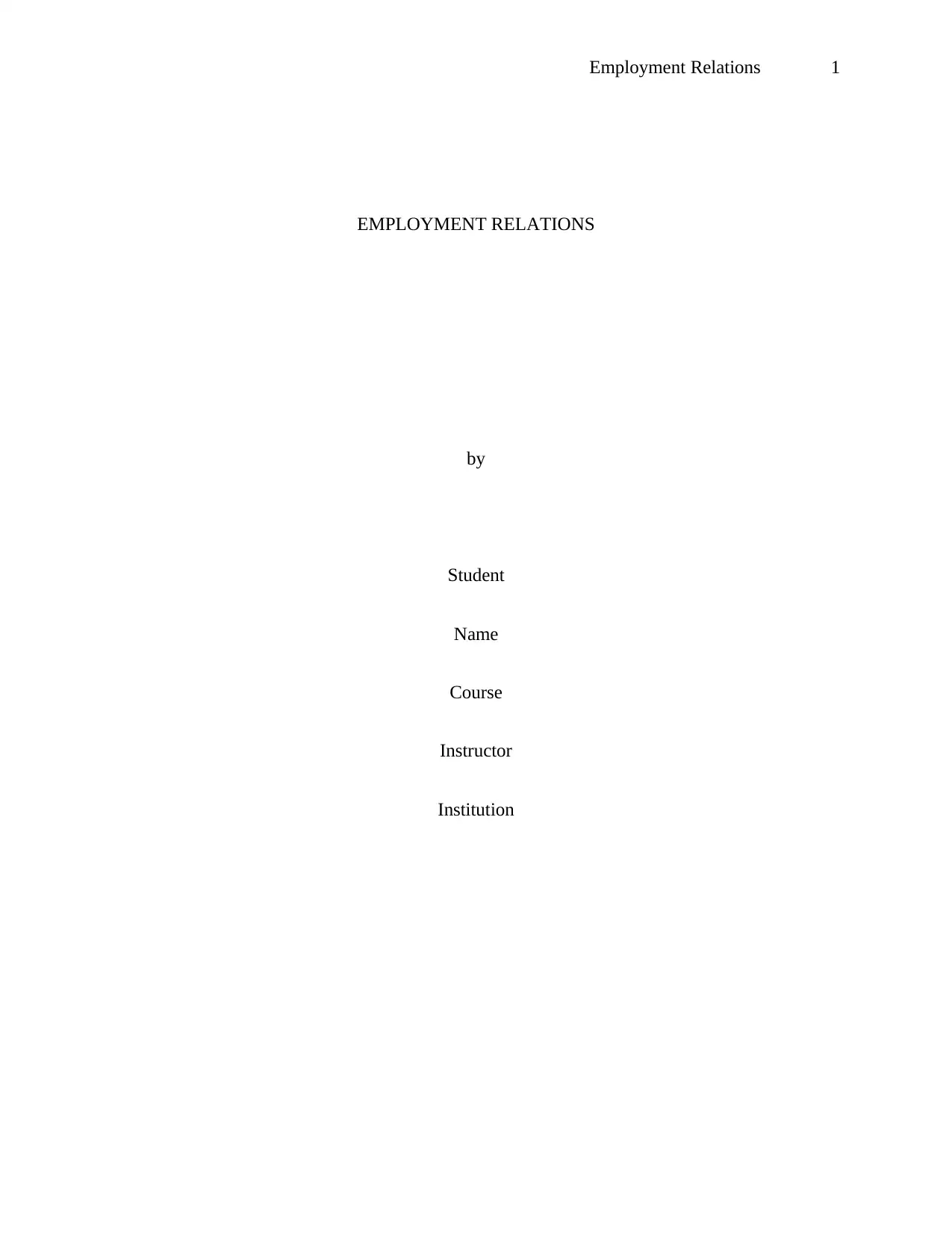
Employment Relations 1
EMPLOYMENT RELATIONS
by
Student
Name
Course
Instructor
Institution
EMPLOYMENT RELATIONS
by
Student
Name
Course
Instructor
Institution
Paraphrase This Document
Need a fresh take? Get an instant paraphrase of this document with our AI Paraphraser
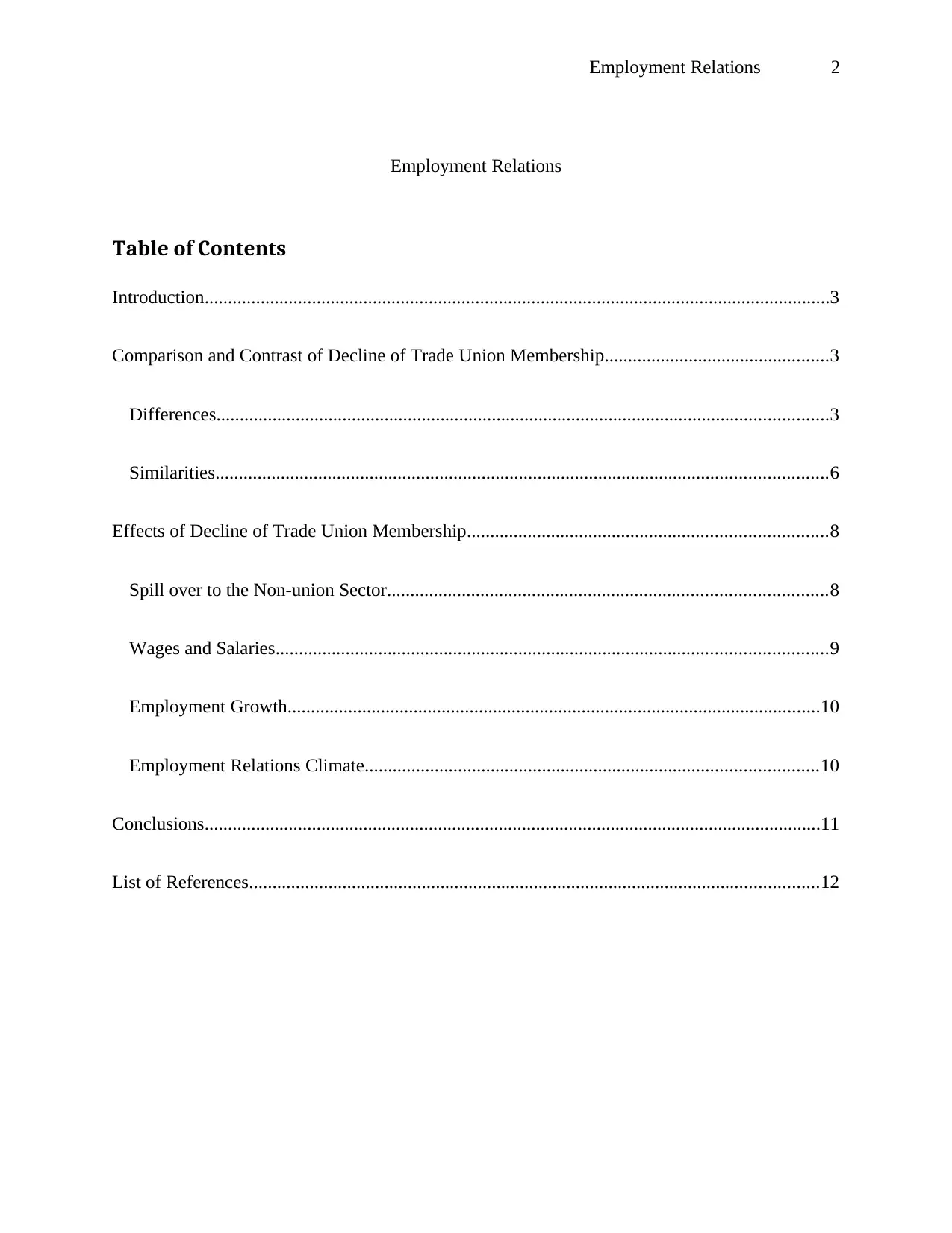
Employment Relations 2
Employment Relations
Table of Contents
Introduction......................................................................................................................................3
Comparison and Contrast of Decline of Trade Union Membership................................................3
Differences...................................................................................................................................3
Similarities...................................................................................................................................6
Effects of Decline of Trade Union Membership.............................................................................8
Spill over to the Non-union Sector..............................................................................................8
Wages and Salaries......................................................................................................................9
Employment Growth..................................................................................................................10
Employment Relations Climate.................................................................................................10
Conclusions....................................................................................................................................11
List of References..........................................................................................................................12
Employment Relations
Table of Contents
Introduction......................................................................................................................................3
Comparison and Contrast of Decline of Trade Union Membership................................................3
Differences...................................................................................................................................3
Similarities...................................................................................................................................6
Effects of Decline of Trade Union Membership.............................................................................8
Spill over to the Non-union Sector..............................................................................................8
Wages and Salaries......................................................................................................................9
Employment Growth..................................................................................................................10
Employment Relations Climate.................................................................................................10
Conclusions....................................................................................................................................11
List of References..........................................................................................................................12
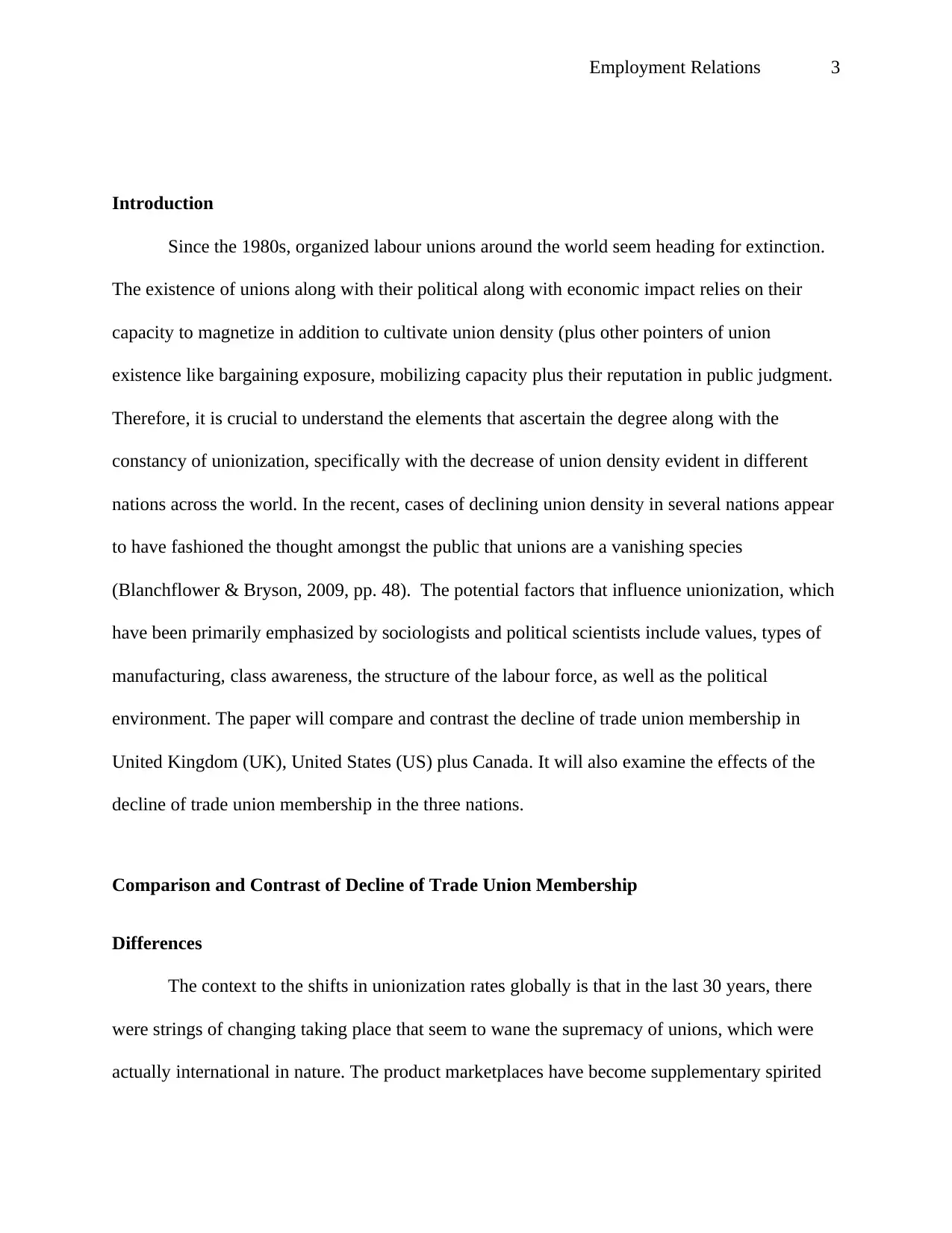
Employment Relations 3
Introduction
Since the 1980s, organized labour unions around the world seem heading for extinction.
The existence of unions along with their political along with economic impact relies on their
capacity to magnetize in addition to cultivate union density (plus other pointers of union
existence like bargaining exposure, mobilizing capacity plus their reputation in public judgment.
Therefore, it is crucial to understand the elements that ascertain the degree along with the
constancy of unionization, specifically with the decrease of union density evident in different
nations across the world. In the recent, cases of declining union density in several nations appear
to have fashioned the thought amongst the public that unions are a vanishing species
(Blanchflower & Bryson, 2009, pp. 48). The potential factors that influence unionization, which
have been primarily emphasized by sociologists and political scientists include values, types of
manufacturing, class awareness, the structure of the labour force, as well as the political
environment. The paper will compare and contrast the decline of trade union membership in
United Kingdom (UK), United States (US) plus Canada. It will also examine the effects of the
decline of trade union membership in the three nations.
Comparison and Contrast of Decline of Trade Union Membership
Differences
The context to the shifts in unionization rates globally is that in the last 30 years, there
were strings of changing taking place that seem to wane the supremacy of unions, which were
actually international in nature. The product marketplaces have become supplementary spirited
Introduction
Since the 1980s, organized labour unions around the world seem heading for extinction.
The existence of unions along with their political along with economic impact relies on their
capacity to magnetize in addition to cultivate union density (plus other pointers of union
existence like bargaining exposure, mobilizing capacity plus their reputation in public judgment.
Therefore, it is crucial to understand the elements that ascertain the degree along with the
constancy of unionization, specifically with the decrease of union density evident in different
nations across the world. In the recent, cases of declining union density in several nations appear
to have fashioned the thought amongst the public that unions are a vanishing species
(Blanchflower & Bryson, 2009, pp. 48). The potential factors that influence unionization, which
have been primarily emphasized by sociologists and political scientists include values, types of
manufacturing, class awareness, the structure of the labour force, as well as the political
environment. The paper will compare and contrast the decline of trade union membership in
United Kingdom (UK), United States (US) plus Canada. It will also examine the effects of the
decline of trade union membership in the three nations.
Comparison and Contrast of Decline of Trade Union Membership
Differences
The context to the shifts in unionization rates globally is that in the last 30 years, there
were strings of changing taking place that seem to wane the supremacy of unions, which were
actually international in nature. The product marketplaces have become supplementary spirited
⊘ This is a preview!⊘
Do you want full access?
Subscribe today to unlock all pages.

Trusted by 1+ million students worldwide
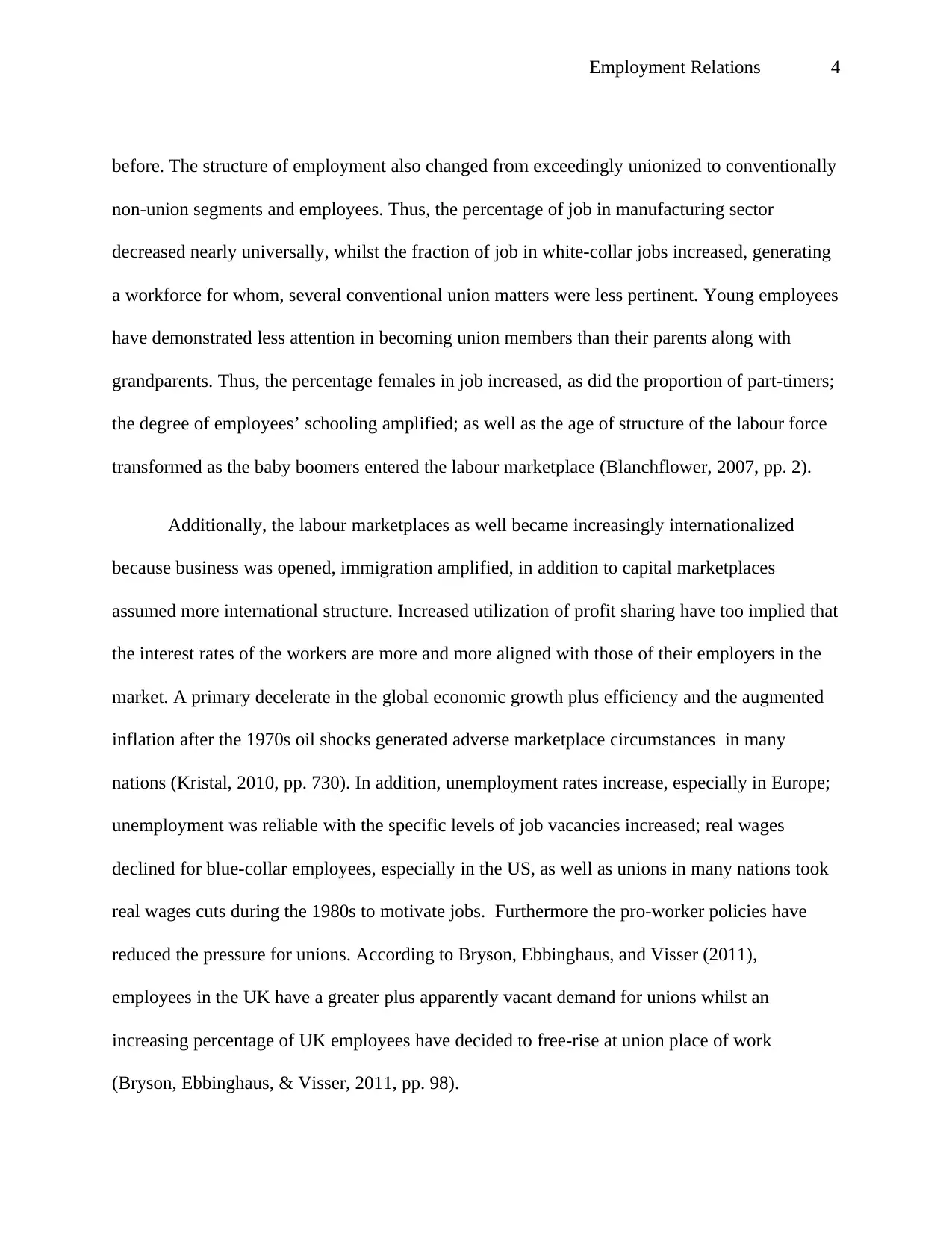
Employment Relations 4
before. The structure of employment also changed from exceedingly unionized to conventionally
non-union segments and employees. Thus, the percentage of job in manufacturing sector
decreased nearly universally, whilst the fraction of job in white-collar jobs increased, generating
a workforce for whom, several conventional union matters were less pertinent. Young employees
have demonstrated less attention in becoming union members than their parents along with
grandparents. Thus, the percentage females in job increased, as did the proportion of part-timers;
the degree of employees’ schooling amplified; as well as the age of structure of the labour force
transformed as the baby boomers entered the labour marketplace (Blanchflower, 2007, pp. 2).
Additionally, the labour marketplaces as well became increasingly internationalized
because business was opened, immigration amplified, in addition to capital marketplaces
assumed more international structure. Increased utilization of profit sharing have too implied that
the interest rates of the workers are more and more aligned with those of their employers in the
market. A primary decelerate in the global economic growth plus efficiency and the augmented
inflation after the 1970s oil shocks generated adverse marketplace circumstances in many
nations (Kristal, 2010, pp. 730). In addition, unemployment rates increase, especially in Europe;
unemployment was reliable with the specific levels of job vacancies increased; real wages
declined for blue-collar employees, especially in the US, as well as unions in many nations took
real wages cuts during the 1980s to motivate jobs. Furthermore the pro-worker policies have
reduced the pressure for unions. According to Bryson, Ebbinghaus, and Visser (2011),
employees in the UK have a greater plus apparently vacant demand for unions whilst an
increasing percentage of UK employees have decided to free-rise at union place of work
(Bryson, Ebbinghaus, & Visser, 2011, pp. 98).
before. The structure of employment also changed from exceedingly unionized to conventionally
non-union segments and employees. Thus, the percentage of job in manufacturing sector
decreased nearly universally, whilst the fraction of job in white-collar jobs increased, generating
a workforce for whom, several conventional union matters were less pertinent. Young employees
have demonstrated less attention in becoming union members than their parents along with
grandparents. Thus, the percentage females in job increased, as did the proportion of part-timers;
the degree of employees’ schooling amplified; as well as the age of structure of the labour force
transformed as the baby boomers entered the labour marketplace (Blanchflower, 2007, pp. 2).
Additionally, the labour marketplaces as well became increasingly internationalized
because business was opened, immigration amplified, in addition to capital marketplaces
assumed more international structure. Increased utilization of profit sharing have too implied that
the interest rates of the workers are more and more aligned with those of their employers in the
market. A primary decelerate in the global economic growth plus efficiency and the augmented
inflation after the 1970s oil shocks generated adverse marketplace circumstances in many
nations (Kristal, 2010, pp. 730). In addition, unemployment rates increase, especially in Europe;
unemployment was reliable with the specific levels of job vacancies increased; real wages
declined for blue-collar employees, especially in the US, as well as unions in many nations took
real wages cuts during the 1980s to motivate jobs. Furthermore the pro-worker policies have
reduced the pressure for unions. According to Bryson, Ebbinghaus, and Visser (2011),
employees in the UK have a greater plus apparently vacant demand for unions whilst an
increasing percentage of UK employees have decided to free-rise at union place of work
(Bryson, Ebbinghaus, & Visser, 2011, pp. 98).
Paraphrase This Document
Need a fresh take? Get an instant paraphrase of this document with our AI Paraphraser
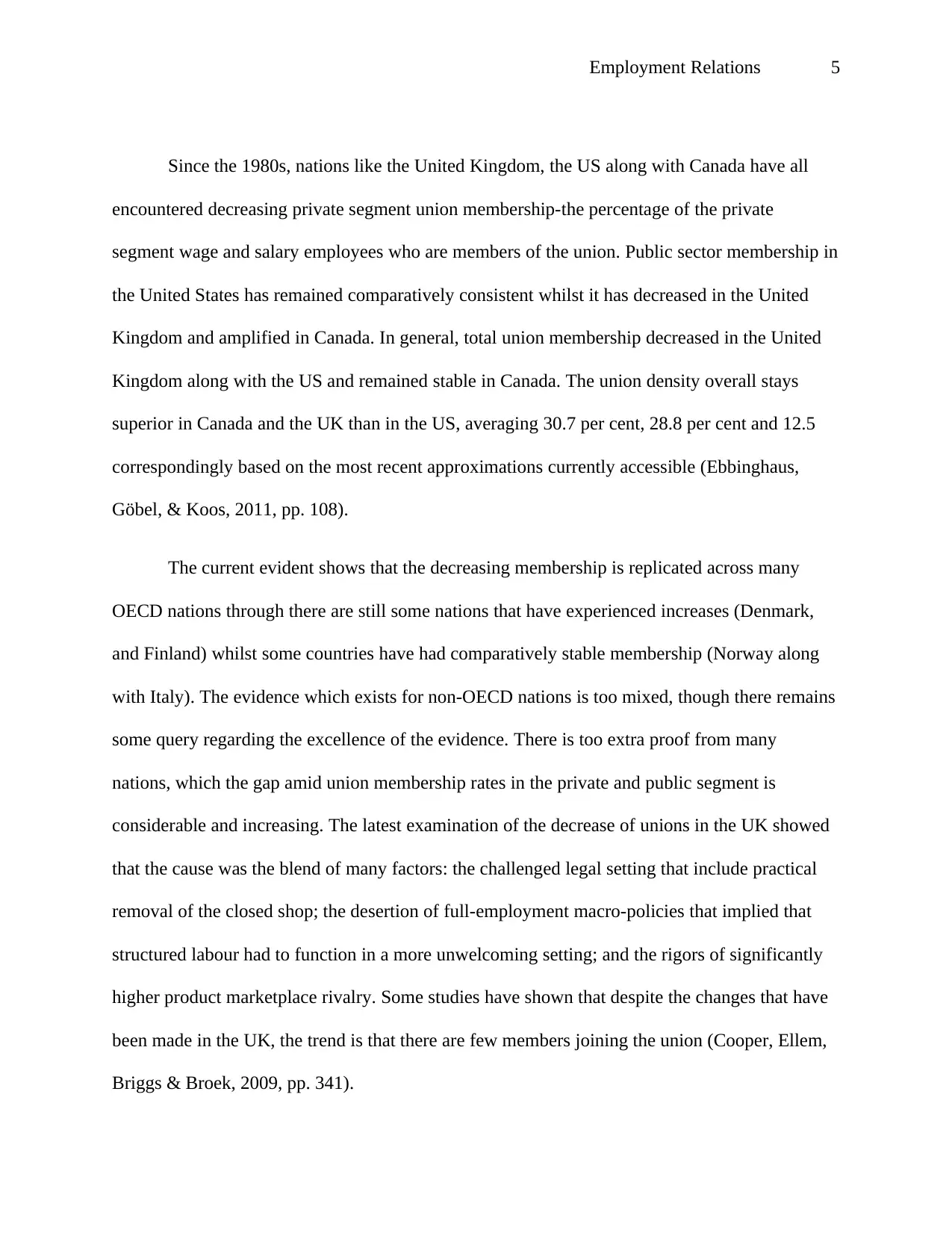
Employment Relations 5
Since the 1980s, nations like the United Kingdom, the US along with Canada have all
encountered decreasing private segment union membership-the percentage of the private
segment wage and salary employees who are members of the union. Public sector membership in
the United States has remained comparatively consistent whilst it has decreased in the United
Kingdom and amplified in Canada. In general, total union membership decreased in the United
Kingdom along with the US and remained stable in Canada. The union density overall stays
superior in Canada and the UK than in the US, averaging 30.7 per cent, 28.8 per cent and 12.5
correspondingly based on the most recent approximations currently accessible (Ebbinghaus,
Göbel, & Koos, 2011, pp. 108).
The current evident shows that the decreasing membership is replicated across many
OECD nations through there are still some nations that have experienced increases (Denmark,
and Finland) whilst some countries have had comparatively stable membership (Norway along
with Italy). The evidence which exists for non-OECD nations is too mixed, though there remains
some query regarding the excellence of the evidence. There is too extra proof from many
nations, which the gap amid union membership rates in the private and public segment is
considerable and increasing. The latest examination of the decrease of unions in the UK showed
that the cause was the blend of many factors: the challenged legal setting that include practical
removal of the closed shop; the desertion of full-employment macro-policies that implied that
structured labour had to function in a more unwelcoming setting; and the rigors of significantly
higher product marketplace rivalry. Some studies have shown that despite the changes that have
been made in the UK, the trend is that there are few members joining the union (Cooper, Ellem,
Briggs & Broek, 2009, pp. 341).
Since the 1980s, nations like the United Kingdom, the US along with Canada have all
encountered decreasing private segment union membership-the percentage of the private
segment wage and salary employees who are members of the union. Public sector membership in
the United States has remained comparatively consistent whilst it has decreased in the United
Kingdom and amplified in Canada. In general, total union membership decreased in the United
Kingdom along with the US and remained stable in Canada. The union density overall stays
superior in Canada and the UK than in the US, averaging 30.7 per cent, 28.8 per cent and 12.5
correspondingly based on the most recent approximations currently accessible (Ebbinghaus,
Göbel, & Koos, 2011, pp. 108).
The current evident shows that the decreasing membership is replicated across many
OECD nations through there are still some nations that have experienced increases (Denmark,
and Finland) whilst some countries have had comparatively stable membership (Norway along
with Italy). The evidence which exists for non-OECD nations is too mixed, though there remains
some query regarding the excellence of the evidence. There is too extra proof from many
nations, which the gap amid union membership rates in the private and public segment is
considerable and increasing. The latest examination of the decrease of unions in the UK showed
that the cause was the blend of many factors: the challenged legal setting that include practical
removal of the closed shop; the desertion of full-employment macro-policies that implied that
structured labour had to function in a more unwelcoming setting; and the rigors of significantly
higher product marketplace rivalry. Some studies have shown that despite the changes that have
been made in the UK, the trend is that there are few members joining the union (Cooper, Ellem,
Briggs & Broek, 2009, pp. 341).
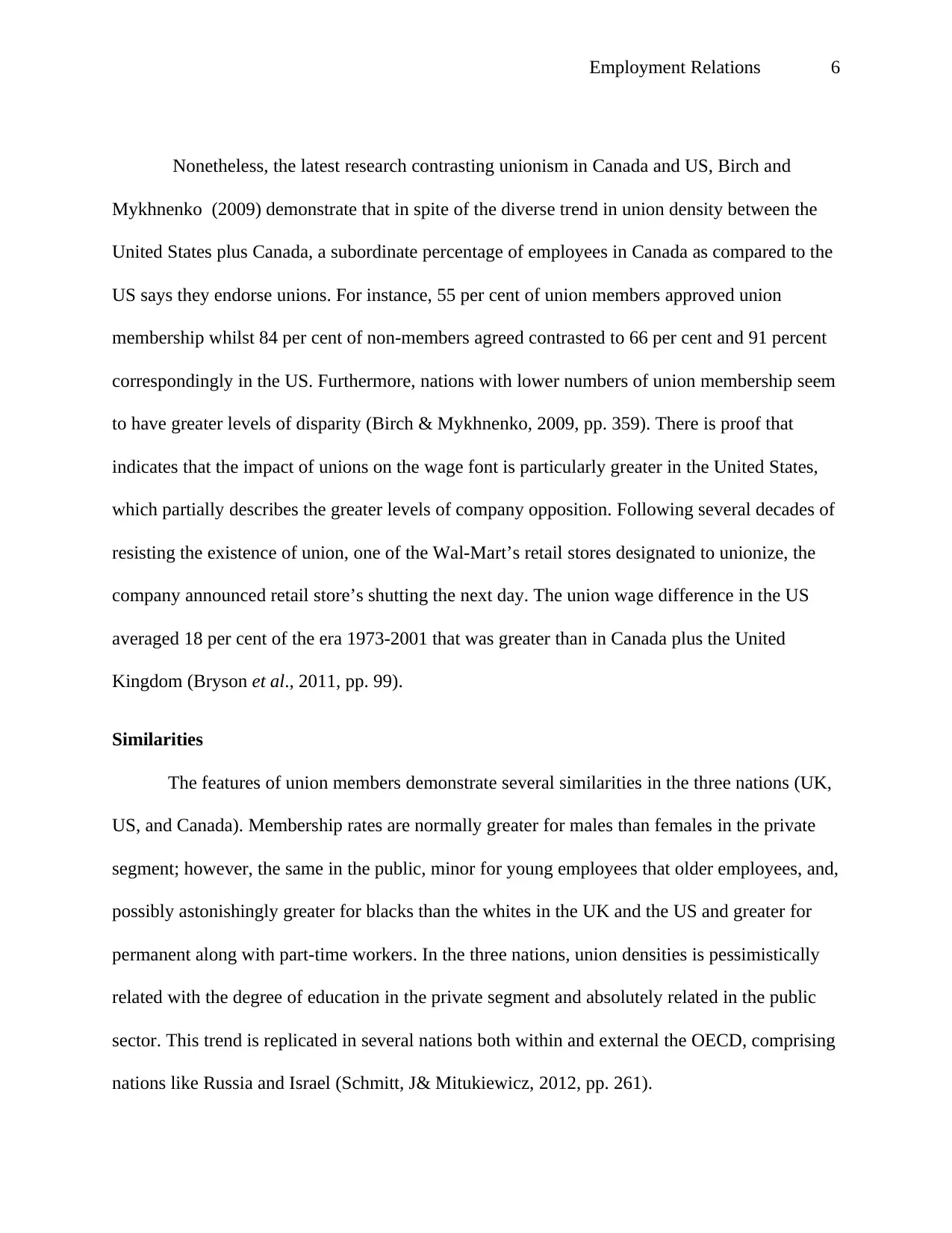
Employment Relations 6
Nonetheless, the latest research contrasting unionism in Canada and US, Birch and
Mykhnenko (2009) demonstrate that in spite of the diverse trend in union density between the
United States plus Canada, a subordinate percentage of employees in Canada as compared to the
US says they endorse unions. For instance, 55 per cent of union members approved union
membership whilst 84 per cent of non-members agreed contrasted to 66 per cent and 91 percent
correspondingly in the US. Furthermore, nations with lower numbers of union membership seem
to have greater levels of disparity (Birch & Mykhnenko, 2009, pp. 359). There is proof that
indicates that the impact of unions on the wage font is particularly greater in the United States,
which partially describes the greater levels of company opposition. Following several decades of
resisting the existence of union, one of the Wal-Mart’s retail stores designated to unionize, the
company announced retail store’s shutting the next day. The union wage difference in the US
averaged 18 per cent of the era 1973-2001 that was greater than in Canada plus the United
Kingdom (Bryson et al., 2011, pp. 99).
Similarities
The features of union members demonstrate several similarities in the three nations (UK,
US, and Canada). Membership rates are normally greater for males than females in the private
segment; however, the same in the public, minor for young employees that older employees, and,
possibly astonishingly greater for blacks than the whites in the UK and the US and greater for
permanent along with part-time workers. In the three nations, union densities is pessimistically
related with the degree of education in the private segment and absolutely related in the public
sector. This trend is replicated in several nations both within and external the OECD, comprising
nations like Russia and Israel (Schmitt, J& Mitukiewicz, 2012, pp. 261).
Nonetheless, the latest research contrasting unionism in Canada and US, Birch and
Mykhnenko (2009) demonstrate that in spite of the diverse trend in union density between the
United States plus Canada, a subordinate percentage of employees in Canada as compared to the
US says they endorse unions. For instance, 55 per cent of union members approved union
membership whilst 84 per cent of non-members agreed contrasted to 66 per cent and 91 percent
correspondingly in the US. Furthermore, nations with lower numbers of union membership seem
to have greater levels of disparity (Birch & Mykhnenko, 2009, pp. 359). There is proof that
indicates that the impact of unions on the wage font is particularly greater in the United States,
which partially describes the greater levels of company opposition. Following several decades of
resisting the existence of union, one of the Wal-Mart’s retail stores designated to unionize, the
company announced retail store’s shutting the next day. The union wage difference in the US
averaged 18 per cent of the era 1973-2001 that was greater than in Canada plus the United
Kingdom (Bryson et al., 2011, pp. 99).
Similarities
The features of union members demonstrate several similarities in the three nations (UK,
US, and Canada). Membership rates are normally greater for males than females in the private
segment; however, the same in the public, minor for young employees that older employees, and,
possibly astonishingly greater for blacks than the whites in the UK and the US and greater for
permanent along with part-time workers. In the three nations, union densities is pessimistically
related with the degree of education in the private segment and absolutely related in the public
sector. This trend is replicated in several nations both within and external the OECD, comprising
nations like Russia and Israel (Schmitt, J& Mitukiewicz, 2012, pp. 261).
⊘ This is a preview!⊘
Do you want full access?
Subscribe today to unlock all pages.

Trusted by 1+ million students worldwide
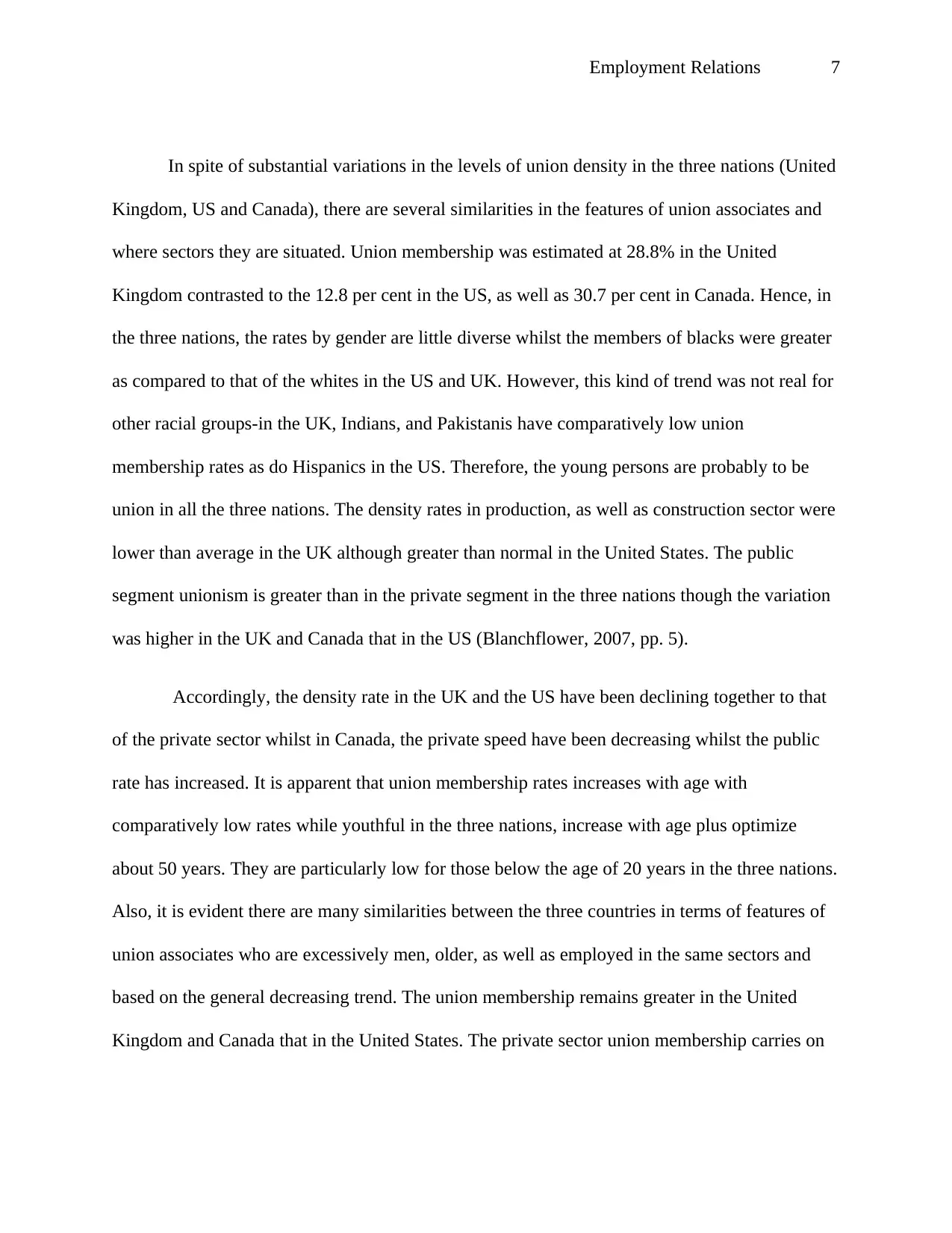
Employment Relations 7
In spite of substantial variations in the levels of union density in the three nations (United
Kingdom, US and Canada), there are several similarities in the features of union associates and
where sectors they are situated. Union membership was estimated at 28.8% in the United
Kingdom contrasted to the 12.8 per cent in the US, as well as 30.7 per cent in Canada. Hence, in
the three nations, the rates by gender are little diverse whilst the members of blacks were greater
as compared to that of the whites in the US and UK. However, this kind of trend was not real for
other racial groups-in the UK, Indians, and Pakistanis have comparatively low union
membership rates as do Hispanics in the US. Therefore, the young persons are probably to be
union in all the three nations. The density rates in production, as well as construction sector were
lower than average in the UK although greater than normal in the United States. The public
segment unionism is greater than in the private segment in the three nations though the variation
was higher in the UK and Canada that in the US (Blanchflower, 2007, pp. 5).
Accordingly, the density rate in the UK and the US have been declining together to that
of the private sector whilst in Canada, the private speed have been decreasing whilst the public
rate has increased. It is apparent that union membership rates increases with age with
comparatively low rates while youthful in the three nations, increase with age plus optimize
about 50 years. They are particularly low for those below the age of 20 years in the three nations.
Also, it is evident there are many similarities between the three countries in terms of features of
union associates who are excessively men, older, as well as employed in the same sectors and
based on the general decreasing trend. The union membership remains greater in the United
Kingdom and Canada that in the United States. The private sector union membership carries on
In spite of substantial variations in the levels of union density in the three nations (United
Kingdom, US and Canada), there are several similarities in the features of union associates and
where sectors they are situated. Union membership was estimated at 28.8% in the United
Kingdom contrasted to the 12.8 per cent in the US, as well as 30.7 per cent in Canada. Hence, in
the three nations, the rates by gender are little diverse whilst the members of blacks were greater
as compared to that of the whites in the US and UK. However, this kind of trend was not real for
other racial groups-in the UK, Indians, and Pakistanis have comparatively low union
membership rates as do Hispanics in the US. Therefore, the young persons are probably to be
union in all the three nations. The density rates in production, as well as construction sector were
lower than average in the UK although greater than normal in the United States. The public
segment unionism is greater than in the private segment in the three nations though the variation
was higher in the UK and Canada that in the US (Blanchflower, 2007, pp. 5).
Accordingly, the density rate in the UK and the US have been declining together to that
of the private sector whilst in Canada, the private speed have been decreasing whilst the public
rate has increased. It is apparent that union membership rates increases with age with
comparatively low rates while youthful in the three nations, increase with age plus optimize
about 50 years. They are particularly low for those below the age of 20 years in the three nations.
Also, it is evident there are many similarities between the three countries in terms of features of
union associates who are excessively men, older, as well as employed in the same sectors and
based on the general decreasing trend. The union membership remains greater in the United
Kingdom and Canada that in the United States. The private sector union membership carries on
Paraphrase This Document
Need a fresh take? Get an instant paraphrase of this document with our AI Paraphraser
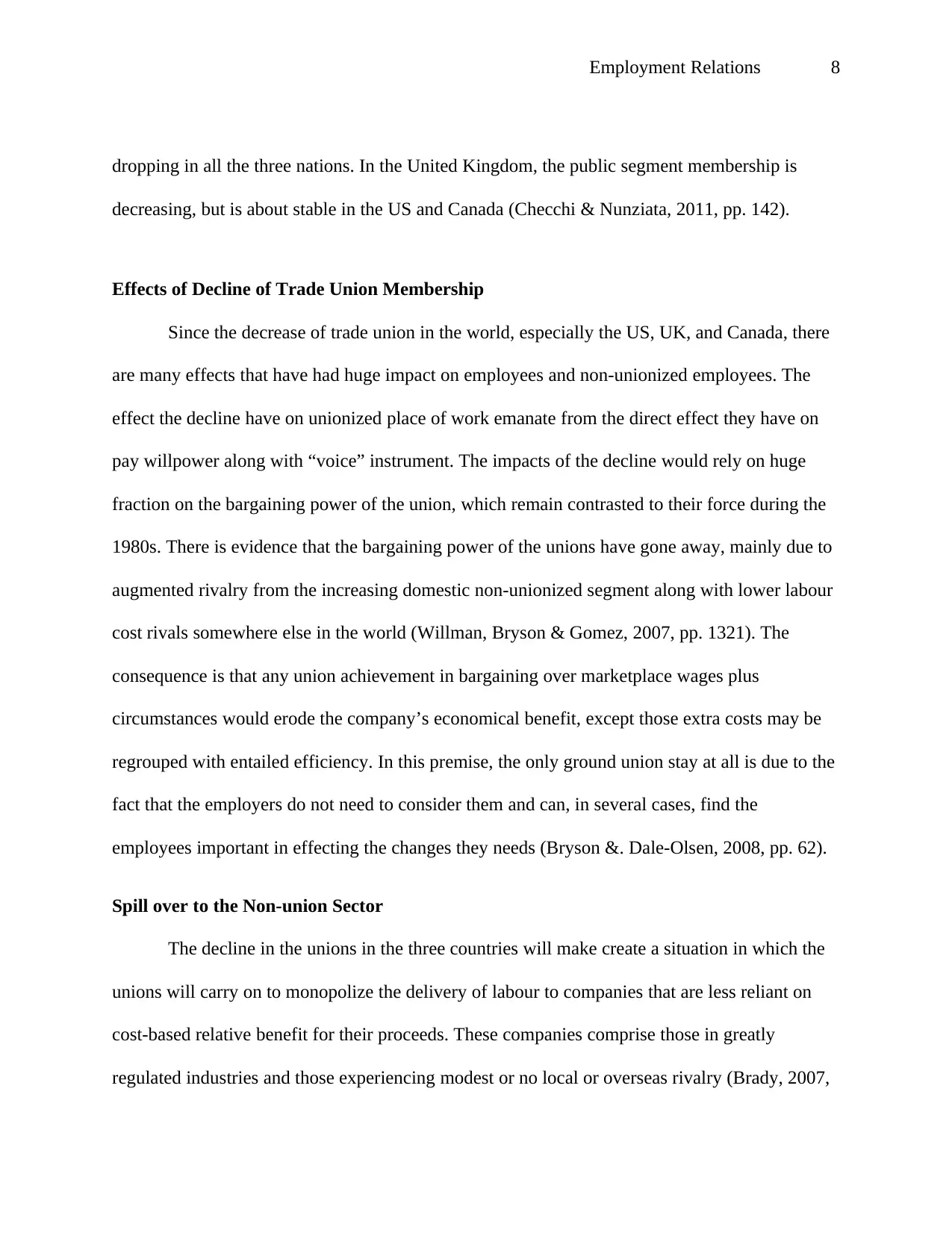
Employment Relations 8
dropping in all the three nations. In the United Kingdom, the public segment membership is
decreasing, but is about stable in the US and Canada (Checchi & Nunziata, 2011, pp. 142).
Effects of Decline of Trade Union Membership
Since the decrease of trade union in the world, especially the US, UK, and Canada, there
are many effects that have had huge impact on employees and non-unionized employees. The
effect the decline have on unionized place of work emanate from the direct effect they have on
pay willpower along with “voice” instrument. The impacts of the decline would rely on huge
fraction on the bargaining power of the union, which remain contrasted to their force during the
1980s. There is evidence that the bargaining power of the unions have gone away, mainly due to
augmented rivalry from the increasing domestic non-unionized segment along with lower labour
cost rivals somewhere else in the world (Willman, Bryson & Gomez, 2007, pp. 1321). The
consequence is that any union achievement in bargaining over marketplace wages plus
circumstances would erode the company’s economical benefit, except those extra costs may be
regrouped with entailed efficiency. In this premise, the only ground union stay at all is due to the
fact that the employers do not need to consider them and can, in several cases, find the
employees important in effecting the changes they needs (Bryson &. Dale-Olsen, 2008, pp. 62).
Spill over to the Non-union Sector
The decline in the unions in the three countries will make create a situation in which the
unions will carry on to monopolize the delivery of labour to companies that are less reliant on
cost-based relative benefit for their proceeds. These companies comprise those in greatly
regulated industries and those experiencing modest or no local or overseas rivalry (Brady, 2007,
dropping in all the three nations. In the United Kingdom, the public segment membership is
decreasing, but is about stable in the US and Canada (Checchi & Nunziata, 2011, pp. 142).
Effects of Decline of Trade Union Membership
Since the decrease of trade union in the world, especially the US, UK, and Canada, there
are many effects that have had huge impact on employees and non-unionized employees. The
effect the decline have on unionized place of work emanate from the direct effect they have on
pay willpower along with “voice” instrument. The impacts of the decline would rely on huge
fraction on the bargaining power of the union, which remain contrasted to their force during the
1980s. There is evidence that the bargaining power of the unions have gone away, mainly due to
augmented rivalry from the increasing domestic non-unionized segment along with lower labour
cost rivals somewhere else in the world (Willman, Bryson & Gomez, 2007, pp. 1321). The
consequence is that any union achievement in bargaining over marketplace wages plus
circumstances would erode the company’s economical benefit, except those extra costs may be
regrouped with entailed efficiency. In this premise, the only ground union stay at all is due to the
fact that the employers do not need to consider them and can, in several cases, find the
employees important in effecting the changes they needs (Bryson &. Dale-Olsen, 2008, pp. 62).
Spill over to the Non-union Sector
The decline in the unions in the three countries will make create a situation in which the
unions will carry on to monopolize the delivery of labour to companies that are less reliant on
cost-based relative benefit for their proceeds. These companies comprise those in greatly
regulated industries and those experiencing modest or no local or overseas rivalry (Brady, 2007,
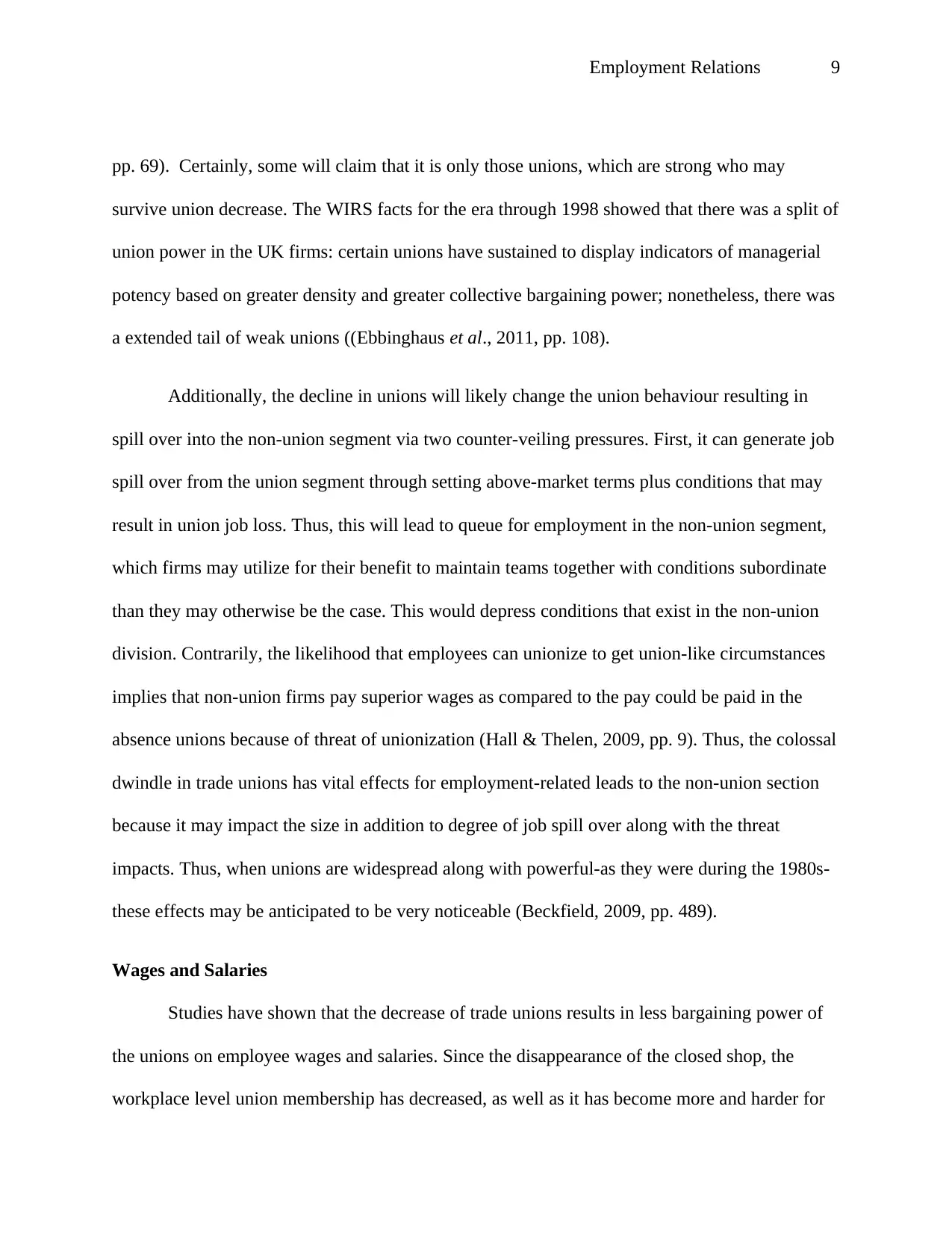
Employment Relations 9
pp. 69). Certainly, some will claim that it is only those unions, which are strong who may
survive union decrease. The WIRS facts for the era through 1998 showed that there was a split of
union power in the UK firms: certain unions have sustained to display indicators of managerial
potency based on greater density and greater collective bargaining power; nonetheless, there was
a extended tail of weak unions ((Ebbinghaus et al., 2011, pp. 108).
Additionally, the decline in unions will likely change the union behaviour resulting in
spill over into the non-union segment via two counter-veiling pressures. First, it can generate job
spill over from the union segment through setting above-market terms plus conditions that may
result in union job loss. Thus, this will lead to queue for employment in the non-union segment,
which firms may utilize for their benefit to maintain teams together with conditions subordinate
than they may otherwise be the case. This would depress conditions that exist in the non-union
division. Contrarily, the likelihood that employees can unionize to get union-like circumstances
implies that non-union firms pay superior wages as compared to the pay could be paid in the
absence unions because of threat of unionization (Hall & Thelen, 2009, pp. 9). Thus, the colossal
dwindle in trade unions has vital effects for employment-related leads to the non-union section
because it may impact the size in addition to degree of job spill over along with the threat
impacts. Thus, when unions are widespread along with powerful-as they were during the 1980s-
these effects may be anticipated to be very noticeable (Beckfield, 2009, pp. 489).
Wages and Salaries
Studies have shown that the decrease of trade unions results in less bargaining power of
the unions on employee wages and salaries. Since the disappearance of the closed shop, the
workplace level union membership has decreased, as well as it has become more and harder for
pp. 69). Certainly, some will claim that it is only those unions, which are strong who may
survive union decrease. The WIRS facts for the era through 1998 showed that there was a split of
union power in the UK firms: certain unions have sustained to display indicators of managerial
potency based on greater density and greater collective bargaining power; nonetheless, there was
a extended tail of weak unions ((Ebbinghaus et al., 2011, pp. 108).
Additionally, the decline in unions will likely change the union behaviour resulting in
spill over into the non-union segment via two counter-veiling pressures. First, it can generate job
spill over from the union segment through setting above-market terms plus conditions that may
result in union job loss. Thus, this will lead to queue for employment in the non-union segment,
which firms may utilize for their benefit to maintain teams together with conditions subordinate
than they may otherwise be the case. This would depress conditions that exist in the non-union
division. Contrarily, the likelihood that employees can unionize to get union-like circumstances
implies that non-union firms pay superior wages as compared to the pay could be paid in the
absence unions because of threat of unionization (Hall & Thelen, 2009, pp. 9). Thus, the colossal
dwindle in trade unions has vital effects for employment-related leads to the non-union section
because it may impact the size in addition to degree of job spill over along with the threat
impacts. Thus, when unions are widespread along with powerful-as they were during the 1980s-
these effects may be anticipated to be very noticeable (Beckfield, 2009, pp. 489).
Wages and Salaries
Studies have shown that the decrease of trade unions results in less bargaining power of
the unions on employee wages and salaries. Since the disappearance of the closed shop, the
workplace level union membership has decreased, as well as it has become more and harder for
⊘ This is a preview!⊘
Do you want full access?
Subscribe today to unlock all pages.

Trusted by 1+ million students worldwide
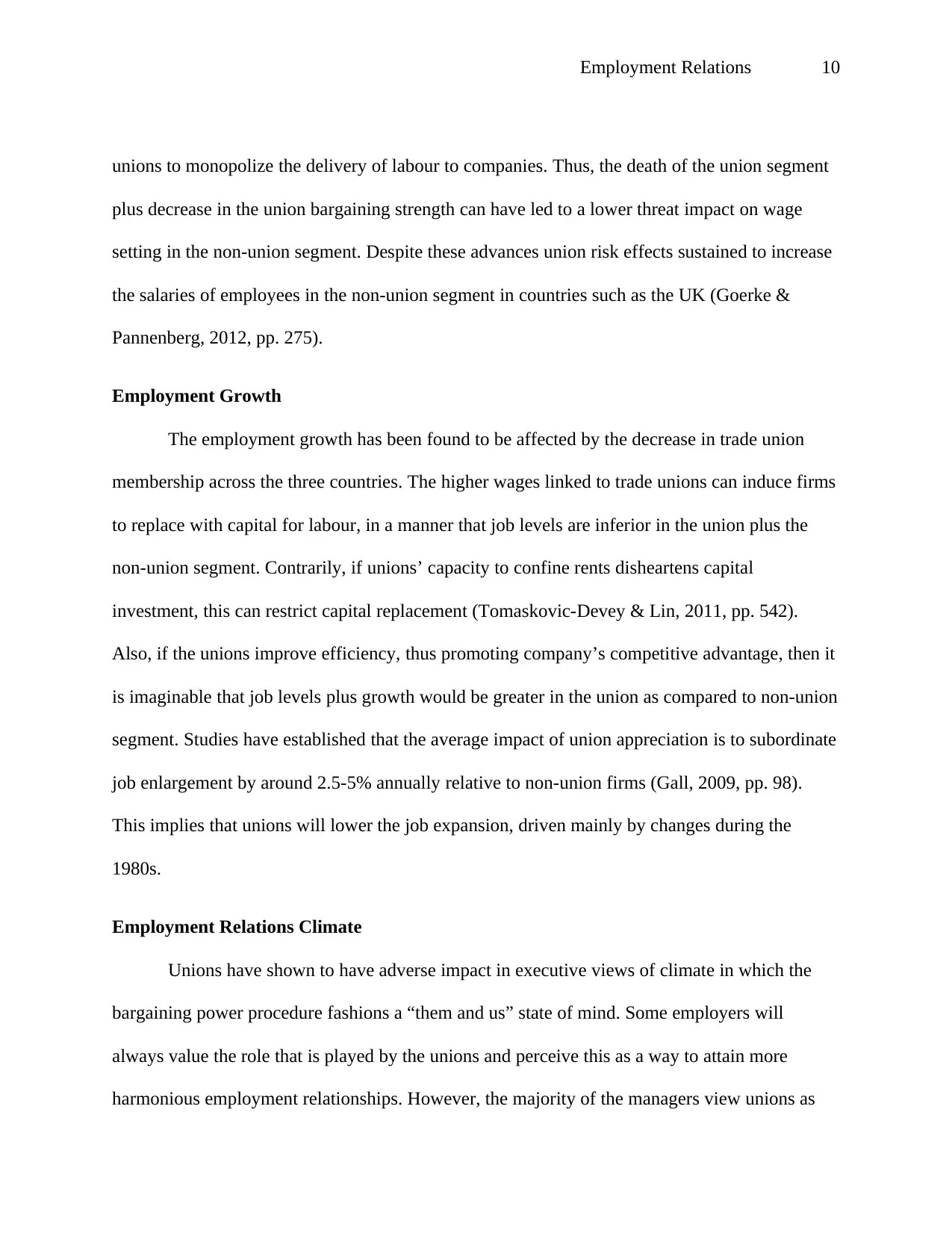
Employment Relations 10
unions to monopolize the delivery of labour to companies. Thus, the death of the union segment
plus decrease in the union bargaining strength can have led to a lower threat impact on wage
setting in the non-union segment. Despite these advances union risk effects sustained to increase
the salaries of employees in the non-union segment in countries such as the UK (Goerke &
Pannenberg, 2012, pp. 275).
Employment Growth
The employment growth has been found to be affected by the decrease in trade union
membership across the three countries. The higher wages linked to trade unions can induce firms
to replace with capital for labour, in a manner that job levels are inferior in the union plus the
non-union segment. Contrarily, if unions’ capacity to confine rents disheartens capital
investment, this can restrict capital replacement (Tomaskovic-Devey & Lin, 2011, pp. 542).
Also, if the unions improve efficiency, thus promoting company’s competitive advantage, then it
is imaginable that job levels plus growth would be greater in the union as compared to non-union
segment. Studies have established that the average impact of union appreciation is to subordinate
job enlargement by around 2.5-5% annually relative to non-union firms (Gall, 2009, pp. 98).
This implies that unions will lower the job expansion, driven mainly by changes during the
1980s.
Employment Relations Climate
Unions have shown to have adverse impact in executive views of climate in which the
bargaining power procedure fashions a “them and us” state of mind. Some employers will
always value the role that is played by the unions and perceive this as a way to attain more
harmonious employment relationships. However, the majority of the managers view unions as
unions to monopolize the delivery of labour to companies. Thus, the death of the union segment
plus decrease in the union bargaining strength can have led to a lower threat impact on wage
setting in the non-union segment. Despite these advances union risk effects sustained to increase
the salaries of employees in the non-union segment in countries such as the UK (Goerke &
Pannenberg, 2012, pp. 275).
Employment Growth
The employment growth has been found to be affected by the decrease in trade union
membership across the three countries. The higher wages linked to trade unions can induce firms
to replace with capital for labour, in a manner that job levels are inferior in the union plus the
non-union segment. Contrarily, if unions’ capacity to confine rents disheartens capital
investment, this can restrict capital replacement (Tomaskovic-Devey & Lin, 2011, pp. 542).
Also, if the unions improve efficiency, thus promoting company’s competitive advantage, then it
is imaginable that job levels plus growth would be greater in the union as compared to non-union
segment. Studies have established that the average impact of union appreciation is to subordinate
job enlargement by around 2.5-5% annually relative to non-union firms (Gall, 2009, pp. 98).
This implies that unions will lower the job expansion, driven mainly by changes during the
1980s.
Employment Relations Climate
Unions have shown to have adverse impact in executive views of climate in which the
bargaining power procedure fashions a “them and us” state of mind. Some employers will
always value the role that is played by the unions and perceive this as a way to attain more
harmonious employment relationships. However, the majority of the managers view unions as
Paraphrase This Document
Need a fresh take? Get an instant paraphrase of this document with our AI Paraphraser
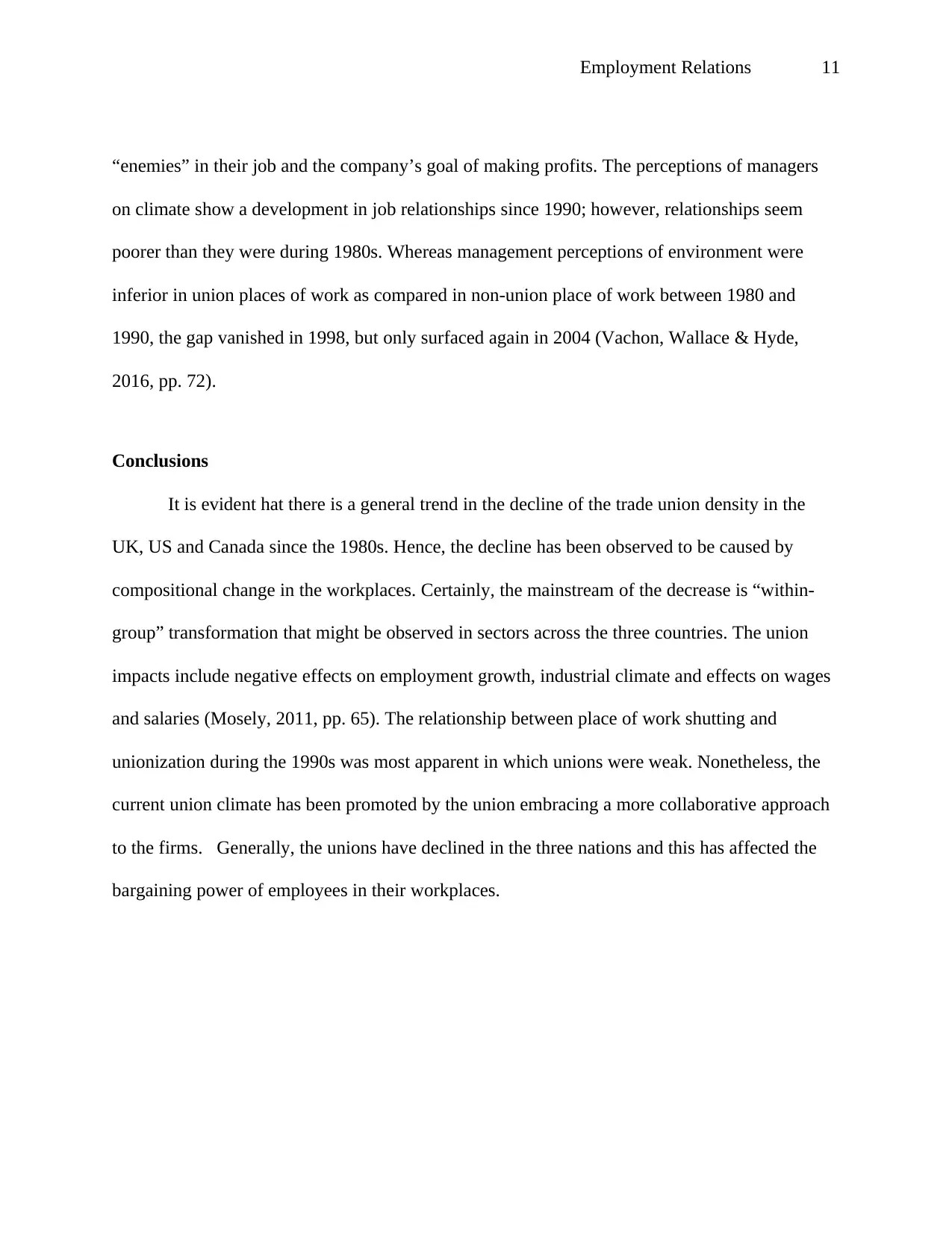
Employment Relations 11
“enemies” in their job and the company’s goal of making profits. The perceptions of managers
on climate show a development in job relationships since 1990; however, relationships seem
poorer than they were during 1980s. Whereas management perceptions of environment were
inferior in union places of work as compared in non-union place of work between 1980 and
1990, the gap vanished in 1998, but only surfaced again in 2004 (Vachon, Wallace & Hyde,
2016, pp. 72).
Conclusions
It is evident hat there is a general trend in the decline of the trade union density in the
UK, US and Canada since the 1980s. Hence, the decline has been observed to be caused by
compositional change in the workplaces. Certainly, the mainstream of the decrease is “within-
group” transformation that might be observed in sectors across the three countries. The union
impacts include negative effects on employment growth, industrial climate and effects on wages
and salaries (Mosely, 2011, pp. 65). The relationship between place of work shutting and
unionization during the 1990s was most apparent in which unions were weak. Nonetheless, the
current union climate has been promoted by the union embracing a more collaborative approach
to the firms. Generally, the unions have declined in the three nations and this has affected the
bargaining power of employees in their workplaces.
“enemies” in their job and the company’s goal of making profits. The perceptions of managers
on climate show a development in job relationships since 1990; however, relationships seem
poorer than they were during 1980s. Whereas management perceptions of environment were
inferior in union places of work as compared in non-union place of work between 1980 and
1990, the gap vanished in 1998, but only surfaced again in 2004 (Vachon, Wallace & Hyde,
2016, pp. 72).
Conclusions
It is evident hat there is a general trend in the decline of the trade union density in the
UK, US and Canada since the 1980s. Hence, the decline has been observed to be caused by
compositional change in the workplaces. Certainly, the mainstream of the decrease is “within-
group” transformation that might be observed in sectors across the three countries. The union
impacts include negative effects on employment growth, industrial climate and effects on wages
and salaries (Mosely, 2011, pp. 65). The relationship between place of work shutting and
unionization during the 1990s was most apparent in which unions were weak. Nonetheless, the
current union climate has been promoted by the union embracing a more collaborative approach
to the firms. Generally, the unions have declined in the three nations and this has affected the
bargaining power of employees in their workplaces.
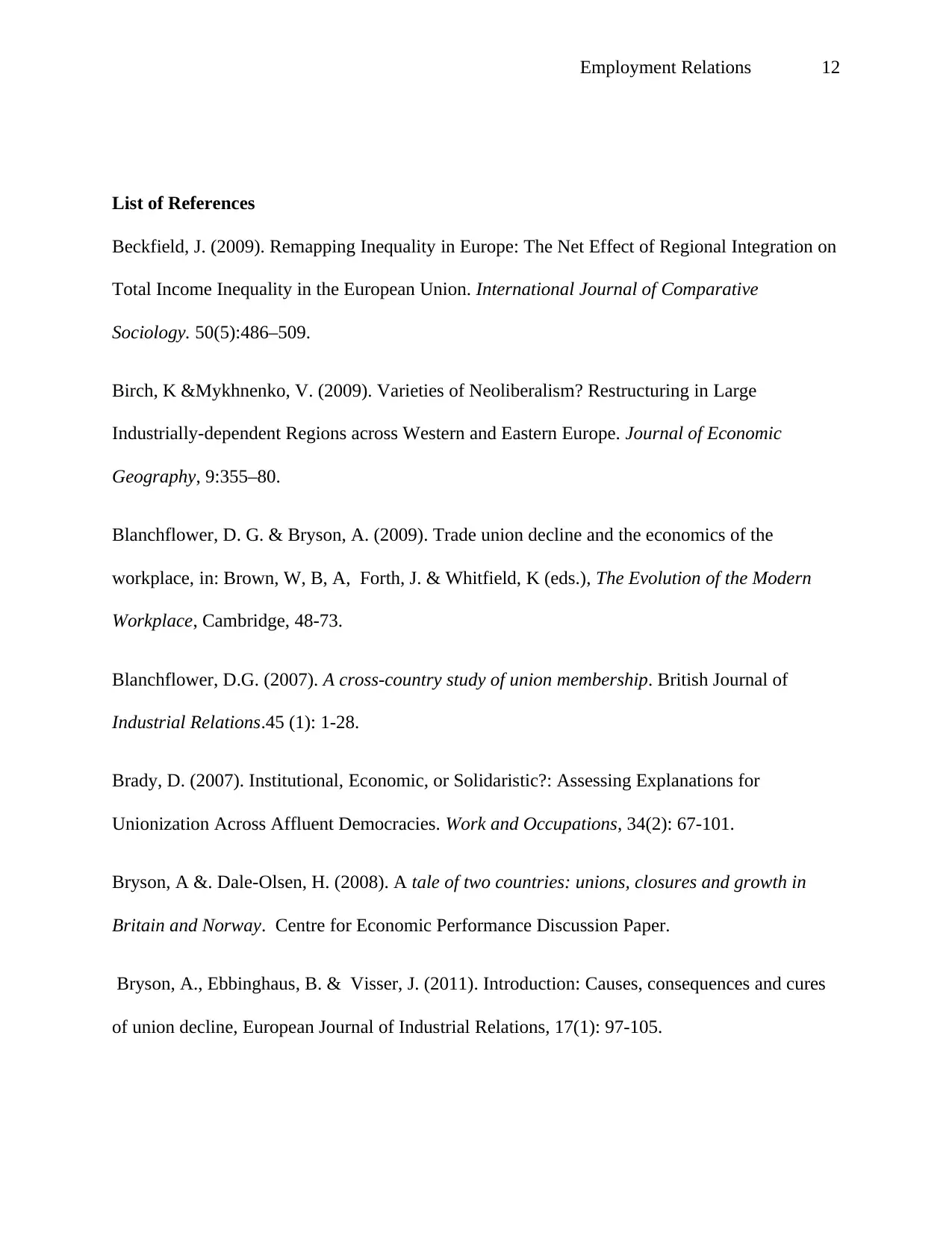
Employment Relations 12
List of References
Beckfield, J. (2009). Remapping Inequality in Europe: The Net Effect of Regional Integration on
Total Income Inequality in the European Union. International Journal of Comparative
Sociology. 50(5):486–509.
Birch, K &Mykhnenko, V. (2009). Varieties of Neoliberalism? Restructuring in Large
Industrially-dependent Regions across Western and Eastern Europe. Journal of Economic
Geography, 9:355–80.
Blanchflower, D. G. & Bryson, A. (2009). Trade union decline and the economics of the
workplace, in: Brown, W, B, A, Forth, J. & Whitfield, K (eds.), The Evolution of the Modern
Workplace, Cambridge, 48-73.
Blanchflower, D.G. (2007). A cross-country study of union membership. British Journal of
Industrial Relations.45 (1): 1-28.
Brady, D. (2007). Institutional, Economic, or Solidaristic?: Assessing Explanations for
Unionization Across Affluent Democracies. Work and Occupations, 34(2): 67-101.
Bryson, A &. Dale-Olsen, H. (2008). A tale of two countries: unions, closures and growth in
Britain and Norway. Centre for Economic Performance Discussion Paper.
Bryson, A., Ebbinghaus, B. & Visser, J. (2011). Introduction: Causes, consequences and cures
of union decline, European Journal of Industrial Relations, 17(1): 97-105.
List of References
Beckfield, J. (2009). Remapping Inequality in Europe: The Net Effect of Regional Integration on
Total Income Inequality in the European Union. International Journal of Comparative
Sociology. 50(5):486–509.
Birch, K &Mykhnenko, V. (2009). Varieties of Neoliberalism? Restructuring in Large
Industrially-dependent Regions across Western and Eastern Europe. Journal of Economic
Geography, 9:355–80.
Blanchflower, D. G. & Bryson, A. (2009). Trade union decline and the economics of the
workplace, in: Brown, W, B, A, Forth, J. & Whitfield, K (eds.), The Evolution of the Modern
Workplace, Cambridge, 48-73.
Blanchflower, D.G. (2007). A cross-country study of union membership. British Journal of
Industrial Relations.45 (1): 1-28.
Brady, D. (2007). Institutional, Economic, or Solidaristic?: Assessing Explanations for
Unionization Across Affluent Democracies. Work and Occupations, 34(2): 67-101.
Bryson, A &. Dale-Olsen, H. (2008). A tale of two countries: unions, closures and growth in
Britain and Norway. Centre for Economic Performance Discussion Paper.
Bryson, A., Ebbinghaus, B. & Visser, J. (2011). Introduction: Causes, consequences and cures
of union decline, European Journal of Industrial Relations, 17(1): 97-105.
⊘ This is a preview!⊘
Do you want full access?
Subscribe today to unlock all pages.

Trusted by 1+ million students worldwide
1 out of 14
Your All-in-One AI-Powered Toolkit for Academic Success.
+13062052269
info@desklib.com
Available 24*7 on WhatsApp / Email
![[object Object]](/_next/static/media/star-bottom.7253800d.svg)
Unlock your academic potential
Copyright © 2020–2025 A2Z Services. All Rights Reserved. Developed and managed by ZUCOL.

